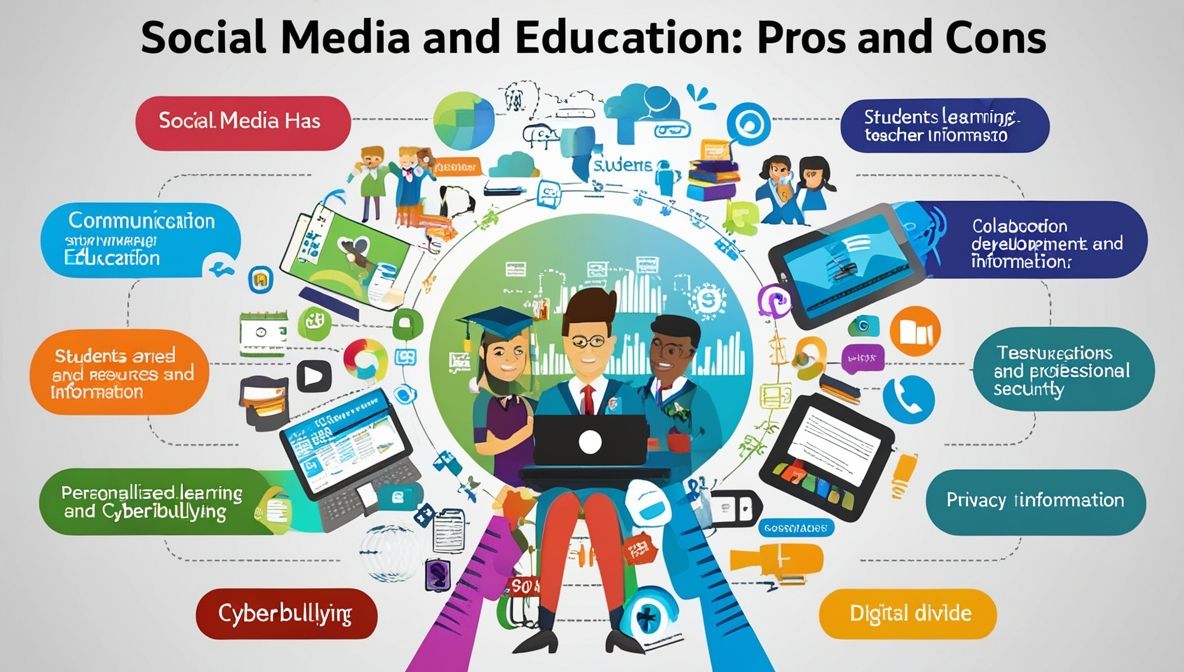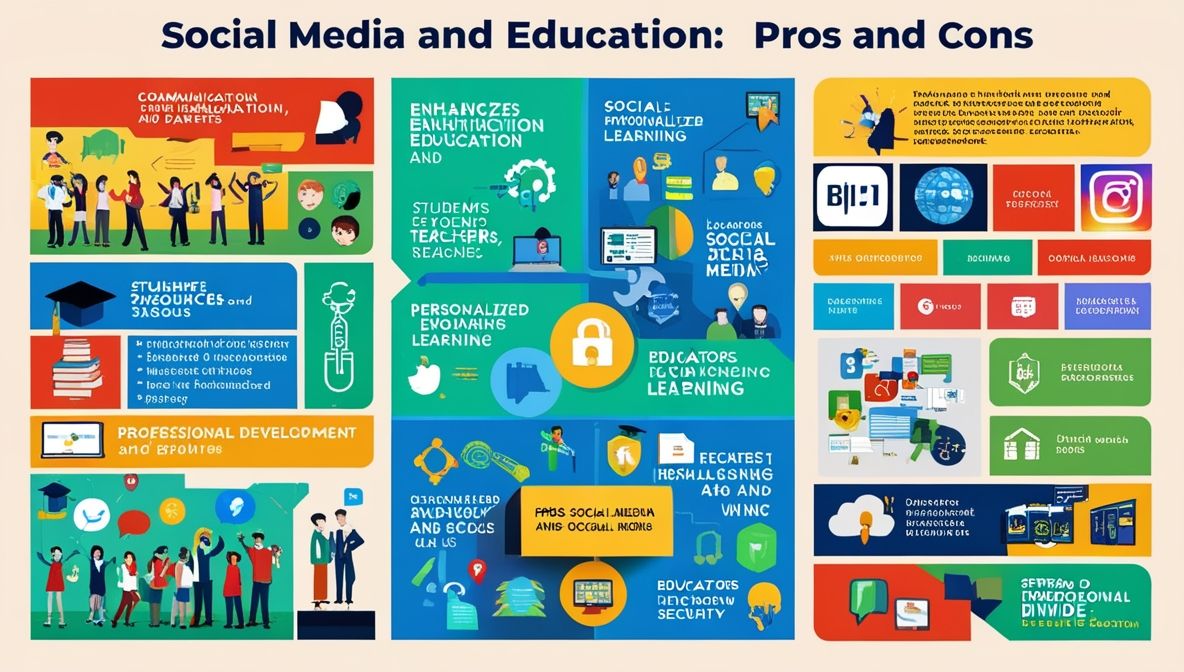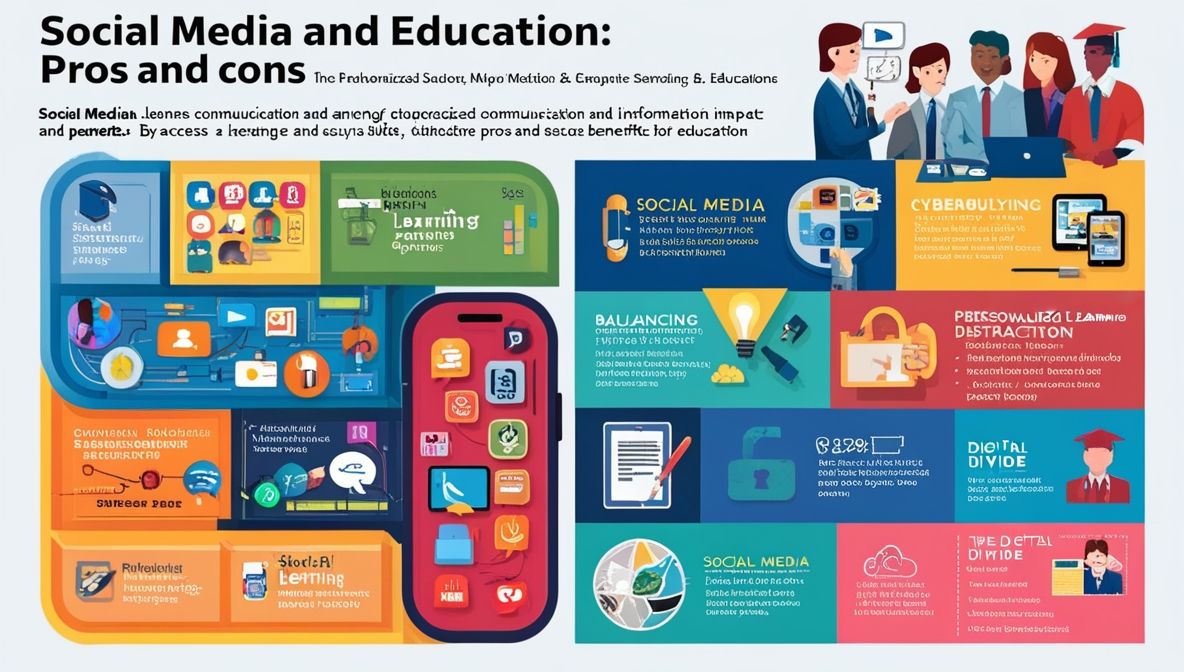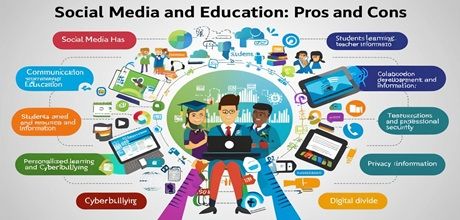Introduction
Social Media and Education Pros and Cons or Social media has become a ubiquitous part of modern life, influencing various sectors, including education. The integration of social media into educational contexts offers numerous advantages but also poses significant challenges. This article explores the pros and cons of using social media in education, providing a comprehensive analysis for educators, students, and policymakers.
Pros of Social Media in Education

- Enhanced Communication and Collaboration
- Instant Communication: Social media platforms like Facebook, Twitter, and WhatsApp facilitate instant communication between students, teachers, and parents. This immediate access helps in clarifying doubts, discussing assignments, and staying updated with school activities.
- Collaborative Learning: Tools such as Google Docs, Slack, and Microsoft Teams allow students to collaborate on projects in real-time, fostering teamwork and collaborative learning. These platforms support group discussions, shared resources, and joint problem-solving activities.
- Access to Resources and Information
- Abundant Educational Content: Platforms like YouTube, Pinterest, and LinkedIn provide a wealth of educational videos, articles, and tutorials. Students can access diverse learning materials that cater to different learning styles and preferences.
- Expert Insights and Global Perspectives: Social media enables students to connect with experts, educators, and peers from around the world. This exposure to global perspectives enhances their understanding of various subjects and broadens their horizons.
- Engagement and Motivation
- Interactive Learning: Social media tools make learning more interactive and engaging. For instance, Twitter can be used for microblogging activities, where students summarize lessons in tweets, fostering concise and critical thinking.
- Gamification: Platforms like Kahoot! and Quizlet integrate gamification into learning, making education fun and competitive. This approach increases student motivation and participation.
- Personalized Learning
- Adaptive Learning Platforms: Social media allows for the creation of personalized learning environments. Platforms like Edmodo and Schoology enable teachers to tailor content to individual student needs, track progress, and provide personalized feedback.
- Self-Paced Learning: Online courses and educational content available on social media enable students to learn at their own pace, revisiting challenging concepts and accelerating through familiar material.
- Professional Development for Educators
- Networking and Collaboration: Social media provides educators with opportunities to connect with colleagues, share best practices, and collaborate on educational initiatives. Platforms like Twitter and LinkedIn host numerous professional development groups and forums.
- Access to Resources: Educators can access a vast array of teaching resources, lesson plans, and professional development materials. Websites like Teachers Pay Teachers and educational blogs offer innovative ideas and strategies.

Cons of Social Media in Education
- Distraction and Time Management
- Procrastination: The addictive nature of social media can lead to procrastination among students. Constant notifications and the allure of non-educational content can distract students from their studies.
- Time Management Issues: Balancing social media usage with academic responsibilities can be challenging. Students may struggle to allocate sufficient time for studying and completing assignments.
- Cyberbullying and Mental Health Concerns
- Cyberbullying: Social media platforms can become arenas for cyberbullying, which can have severe psychological effects on students. Victims of cyberbullying may experience anxiety, depression, and a decline in academic performance.
- Mental Health: Excessive use of social media is linked to mental health issues such as anxiety, depression, and low self-esteem. The constant comparison with peers and the pressure to maintain an online image can be detrimental to students’ well-being.
- Privacy and Security Issues
- Data Privacy: The collection and sharing of personal data on social media platforms raise significant privacy concerns. Students’ information can be vulnerable to misuse by third parties, leading to identity theft and other security risks.
- Security Threats: The risk of hacking, phishing, and other cyber threats is a major concern. Schools and educators must implement robust security measures to protect students’ data and privacy.
- Misinformation and Reliability of Content
- Spread of Misinformation: Social media is a breeding ground for misinformation and fake news. Students may encounter inaccurate or misleading information, which can affect their learning and understanding of subjects.
- Reliability of Sources: The credibility of content on social media is often questionable. Students need to be taught critical thinking skills to discern reliable sources from unreliable ones.
- Digital Divide
- Access Inequality: Not all students have equal access to social media and digital devices. This digital divide can exacerbate educational inequalities, leaving some students at a disadvantage.
- Skill Gaps: Variations in digital literacy skills among students can hinder the effective use of social media for educational purposes. Educators need to address these skill gaps to ensure all students can benefit equally.

Balancing the Pros and Cons
To maximize the benefits and mitigate the drawbacks of social media in education, a balanced approach is essential.Social Media and Education Pros and Cons or Social media. Here are some strategies:
- Establish Clear Guidelines and Policies
- Schools and educators should develop clear guidelines and policies for the use of social media in education. These policies should address issues such as appropriate use, privacy, and cyberbullying.
- Promote Digital Literacy
- Educators should integrate digital literacy into the curriculum, teaching students how to use social media responsibly and effectively. This includes critical thinking skills for evaluating online content and understanding the implications of digital footprints.
- Foster a Positive Online Environment
- Schools should create a supportive online environment that promotes positive interactions and discourages cyberbullying. This can be achieved through awareness programs, peer support groups, and counseling services.
- Leverage Educational Platforms
- Utilize educational platforms specifically designed for learning, such as Edmodo, Schoology, and Google Classroom. These platforms offer a safer and more controlled environment compared to mainstream social media.
- Encourage Parental Involvement
- Parents should be encouraged to monitor and guide their children’s social media usage. Parental involvement is crucial in ensuring that students use social media responsibly and maintain a healthy balance between online and offline activities.
- Provide Professional Development for Educators
- Continuous professional development is essential for educators to stay updated with the latest trends and best practices in integrating social media into education. Training programs and workshops can help teachers effectively incorporate social media tools into their teaching strategies.
Conclusion
Social media has the potential to revolutionize education by enhancing communication, collaboration, and access to information. However, its integration into educational contexts must be approached with caution due to the associated risks such as distraction, cyberbullying, privacy concerns, and misinformation. By establishing clear guidelines, promoting digital literacy, fostering a positive online environment, leveraging educational platforms, encouraging parental involvement, and providing professional development for educators, the benefits of social media in education can be maximized while minimizing its drawbacks. Ultimately, a balanced approach that harnesses the positive aspects of social media while mitigating its negative impacts will lead to a more effective and enriching educational experience for students.

knsouf
I have been exploring for a bit for any high quality articles or weblog posts in this kind of house . Exploring in Yahoo I finally stumbled upon this web site. Reading this info So i am glad to convey that I’ve a very just right uncanny feeling I found out just what I needed. I so much undoubtedly will make certain to do not overlook this website and give it a glance regularly.
Temukan peluang menang besar di Shark Bounty : Slot Online Gacor yang Menjanjikan
0imap0
I am happy that I discovered this site, just the right information that I was looking for! .
This blog is definitely rather handy since I’m at the moment creating an internet floral website – although I am only starting out therefore it’s really fairly small, nothing like this site. Can link to a few of the posts here as they are quite. Thanks much. Zoey Olsen
Just wanna comment that you have a very nice website , I like the pattern it really stands out.
Wonderful work! This is the type of info that should be shared around the web. Shame on the search engines for no longer positioning this publish higher! Come on over and talk over with my web site . Thank you =)
Some truly choice articles on this web site, saved to favorites.
There are certainly numerous particulars like that to take into consideration. That may be a nice level to bring up. I supply the thoughts above as normal inspiration but clearly there are questions like the one you convey up where a very powerful thing will be working in trustworthy good faith. I don?t know if best practices have emerged round issues like that, but I am certain that your job is clearly identified as a fair game. Each boys and girls really feel the impact of only a second’s pleasure, for the rest of their lives.
Really instructive and good complex body part of content, now that’s user friendly (:.
What’s Happening i am new to this, I stumbled upon this I’ve found It positively useful and it has aided me out loads. I hope to contribute & help other users like its helped me. Good job.
Hello. fantastic job. I did not anticipate this. This is a excellent story. Thanks!
I have been browsing online more than three hours lately, yet I by no means found any attention-grabbing article like yours. It?¦s lovely worth enough for me. Personally, if all website owners and bloggers made excellent content as you did, the net will probably be a lot more useful than ever before.
Cool blog! Is your theme custom made or did you download it from somewhere? A theme like yours with a few simple adjustements would really make my blog shine. Please let me know where you got your theme. Bless you
I found your blog web site on google and examine just a few of your early posts. Proceed to maintain up the superb operate. I simply additional up your RSS feed to my MSN Information Reader. Seeking forward to reading extra from you afterward!…
Good day! This post could not be written any better! Reading through this post reminds me of my good old room mate! He always kept talking about this. I will forward this article to him. Fairly certain he will have a good read. Thank you for sharing!
Hello my family member! I wish to say that this post is awesome, great written and come with almost all important infos. I would like to look more posts like this .
This content is really helpful, especially for beginners like me.